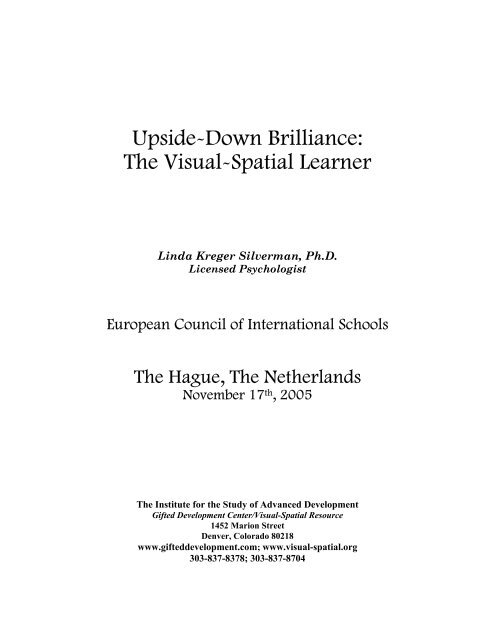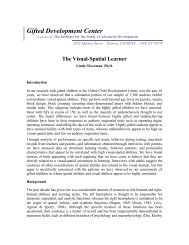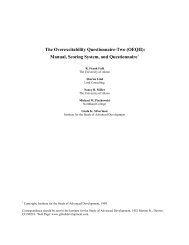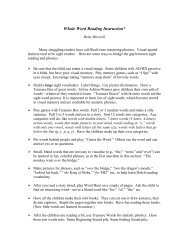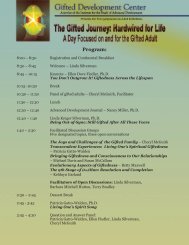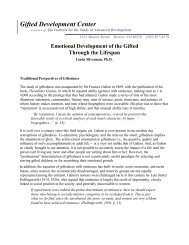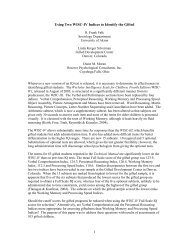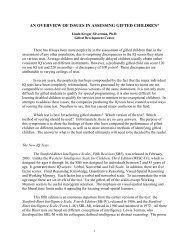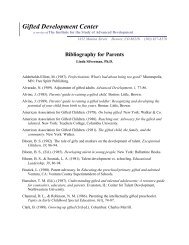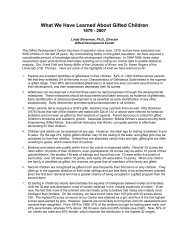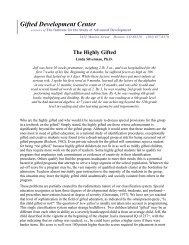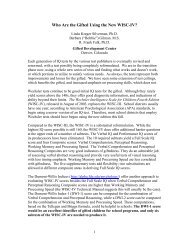Upside-Down Brillian.. - the Gifted Development Center
Upside-Down Brillian.. - the Gifted Development Center
Upside-Down Brillian.. - the Gifted Development Center
Create successful ePaper yourself
Turn your PDF publications into a flip-book with our unique Google optimized e-Paper software.
Please complete <strong>the</strong> following quiz to find out moreabout your learning style.YesNo1. Do you think mainly in pictures instead of in words?2. Do you know things without being able to explain how or why?3. Do you solve problems in unusual ways?4. Do you have a vivid imagination?5. Do you remember what you see and forget what you hear?6. Are you terrible at spelling?7. Can you visualize objects from different perspectives?8. Are you organizationally impaired?9. Do you often lose track of time?10 Would you ra<strong>the</strong>r read a map than follow verbal directions?11. Do you remember how to get to places you visited only once?12 Is your handwriting difficult for o<strong>the</strong>rs to read?13 Can you feel what o<strong>the</strong>rs are feeling?14 Are you musically, artistically, or mechanically inclined?15 Do you know more than o<strong>the</strong>rs think you know?16 Do you hate speaking in front of a group?17 Did you feel smarter as you got older?18. Are you addicted to your computer?If you answered yes to 10 of <strong>the</strong> above questions, you are verylikely to be a visual-spatial learner.From Silverman, L.K. (2002). <strong>Upside</strong>-<strong>Down</strong> <strong>Brillian</strong>ce: The Visual-Spatial Learner. Denver: DeLeon Publishing.May be reproduced.
Visual-Spatial LearnerCharacteristics ComparisonThe Auditory-Sequential LearnerThinks primarily in wordsHas auditory strengthsRelates well to timeIs a step-by-step learnerLearns by trial and errorProgresses sequentially from easyto difficult materialIs an analytical thinkerAttends well to detailsFollows oral directions wellDoes well at arithmeticLearns phonics easilyCan sound out spelling wordsCan write quickly and neatlyIs well organizedCan show steps of work easilyExcels at rote memorizationHas good auditory short-term memoryMay need some repetitionto reinforce learningLearns well from instructionsLearns in spite of emotional reactionsIs comfortable with one right answerDevelops fairly evenlyUsually maintains high gradesEnjoys algebra and chemistryMasters o<strong>the</strong>r languages in classesIs academically talentedIs an early bloomerThinks primarily in imagesHas visual strengthsRelates well to spaceIs a whole-part learnerLearns concepts all at onceThe Visual-Spatial LearnerLearns complex concepts easily;struggles with easy skillsIs a good syn<strong>the</strong>sizerSees <strong>the</strong> big picture; may miss detailsReads maps wellIs better at math reasoning than computationLearns whole words easilyMust visualize words to spell <strong>the</strong>mMuch better at keyboarding than handwritingCreates unique methods of organizationArrives at correct solutions intuitivelyLearns best by seeing relationshipsHas good long-term visual memoryLearns concepts permanently; does not learnby drill and repetitionDevelops own methods of problem solvingIs very sensitive to teachers' attitudesGenerates unusual solutions to problemsDevelops quite asynchronously (unevenly)May have very uneven gradesEnjoys geometry and physicsMasters o<strong>the</strong>r languages through immersionIs creatively, mechanically, technologically, emotionallyor spiritually giftedIs a late bloomer
Research from <strong>the</strong> <strong>Gifted</strong> <strong>Development</strong> <strong>Center</strong> concludes:About 1/3StronglyVisual-SpatialAbout 1/4StronglyAuditory-SequentialAbout 45% Rely onboth hemispheres30% lean toward VSL;15% lean to ASLThe study included 750 4 th , 5 th and 6 th graders, white andHispanic, from urban and rural schools, all socio-economicbackgrounds and all IQ ranges.
The Visual-Spatial IdentifierSelf-Report1. I hate speaking in front of a group.2. I think mainly in pictures instead of words.3. I am good at spelling (not).4. I often lose track of time.5. I know more than o<strong>the</strong>rs think I know.6. I don’t do well with tests with time limits.7. I have neat handwriting (not).8. I have a wild imagination.9. I like to take things apart to find out how <strong>the</strong>y work.10. I hate writing assignments.11. I solve problems in unusual ways.12. It’s much easier for me to tell you about things than to write<strong>the</strong>m down.13. I have a hard time explaining how I came up with myanswers.14. I am well organized (not).15. It was easy for me to memorize my math facts (not).Why All Students Need Visual-Spatial Methods
Linda Kreger Silverman, Ph.D.The first child I observed with unusual visual-spatial abilities was profoundly gifted (above175 IQ). So I assumed that visual-spatial learners were profoundly gifted. Then, I discoveredthat children who fit <strong>the</strong> characteristics of giftedness, but did not test in <strong>the</strong> gifted range due tohidden learning disabilities, were usually visual-spatial learners. So I thought that visualspatiallearners were ei<strong>the</strong>r profoundly gifted or twice exceptional (gifted with learningdisabilities).In 1991, I was asked to create a video on visual-spatial learners for <strong>the</strong> state of Missouri; <strong>the</strong>Director of Curriculum was convinced that <strong>the</strong> information would be applicable in all subjectareas and at all grade levels, from Kindergarten through 12 th grade. I was uncertain at <strong>the</strong>time, but he turned out to be right.When we developed <strong>the</strong> Visual-Spatial Identifier, a process that began in 1992 and took <strong>the</strong>better part of a decade, we still thought that a small percentage of <strong>the</strong> population would turnout to be visual-spatial learners. The results of <strong>the</strong> second validation study of our Identifier,in 2001, astounded us! Approximately one-third of <strong>the</strong> 750 students we had assessed in twoschools were strongly visual-spatial and ano<strong>the</strong>r 30% were moderately visual-spatial. Thatrepresented <strong>the</strong> majority of <strong>the</strong> school population!As I was completing <strong>Upside</strong>-<strong>Down</strong> <strong>Brillian</strong>ce: The Visual-Spatial Learner, published at <strong>the</strong>end of 2002, I realized more clearly what Dr. Jerre Levy had said: “Unless <strong>the</strong> righ<strong>the</strong>misphere is activated and engaged, attention is low and learning is poor.” She was talkingabout every student in <strong>the</strong> classroom.Throughout <strong>the</strong> book I hinted that <strong>the</strong> visual-spatial learner might soon have <strong>the</strong> edge ingaining employment. Tom West (1991), author of In <strong>the</strong> Mind’s Eye, suggests that in <strong>the</strong> 21 stcentury employees will require strong visual skills: “ready recognition of larger patterns,intuition, a sense of proportion, imaginative vision, <strong>the</strong> original and unexpected approach, and<strong>the</strong> apt connection between apparently unrelated things” (p. 88).Daniel H. Pink (2005), author of A Whole New Mind: Moving from <strong>the</strong> Information Age to<strong>the</strong> Conceptual Age, proposes that, now that information is readily available on <strong>the</strong> Internet,success in today’s world is dependent on empathy, intuition, spirituality and righ<strong>the</strong>mispheric-directed abilities.“In <strong>the</strong> United States, <strong>the</strong> number of graphic designers has increased tenfold ina decade; graphic designers outnumber chemical engineers by four to one.Since 1970, <strong>the</strong> United States has 30% more people earning a living as writersand 50% more earning a living by composing or performing music. … MoreAmericans today work in arts, entertainment and design than work as lawyers,accountants and auditors.” (p. 55)
I began thinking about how schools are preparing students for success in <strong>the</strong>ir careers. It isvery likely that until <strong>the</strong> modern age <strong>the</strong> skills emphasized in school were necessary forachievement in adult life. However, <strong>the</strong> world is changing very quickly and our educationalsystems are not keeping pace. Success in school still depends upon:Following directionsTurning in assigned work on timeMemorization of factsFast recallShowing steps of workNeat, legible handwritingAccurate spellingPunctualityGood organization; tidinessWhat positions require <strong>the</strong> skills so heavily prized in school? These auditory-sequential skillsare actually limiting <strong>the</strong> potential of all students to gain employment in today’s world.Citizens of <strong>the</strong> 21 st century are rewarded beyond school for:Ability to predict trendsGrasping <strong>the</strong> big pictureThinking outside <strong>the</strong> boxRisk-takingProblem-finding and problem-solving skillsCombining one’s strengths with o<strong>the</strong>rs’ to build a strong teamComputer literacyDealing with complexityAbility to read people wellIsn’t it time we recognize <strong>the</strong> importance of right-hemispheric abilities and provide allstudents <strong>the</strong> opportunity to develop <strong>the</strong>ir visual-spatial skills? These skills are essential to<strong>the</strong>ir success in adult life. To continue to prepare students for jobs in <strong>the</strong> 1950s is limiting<strong>the</strong>ir potential instead of enhancing it. One of <strong>the</strong> central functions of school has always beento prepare <strong>the</strong> citizenry for gainful employment.Are we missing <strong>the</strong> mark?Prepared for <strong>the</strong> Visual-Spatial Resource website: www.visualspatial.org
CharacteristicsIndividuals who exhibit stronger visual-spatial abilities than auditory sequentialabilities are considered visual-spatial learners. They do extraordinarily well on tasks withspatial components: solving puzzles, tracing mazes, duplicating block designs, countingthree-dimensional arrays of blocks, visual transformations, mental rotations, envisioning howa folded and cut piece of paper would appear opened up, and similar items. The BlockDesign subtest of <strong>the</strong> Wechsler Intelligence Scale for Children (WISC) is one of <strong>the</strong> strongestindicators of <strong>the</strong> visual-spatial learning style. The Abstract Visual Reasoning section of <strong>the</strong>Stanford-Binet Fourth Edition and <strong>the</strong> Raven's Progressive Matrices also assess spatialabilities. The Mental Rotations Test has been used in several studies to detect children wi<strong>the</strong>xtremely strong visual-spatial and ma<strong>the</strong>matical talents.Visual-spatial learners perceive <strong>the</strong> interrelatedness of <strong>the</strong> parts of any situation.Their learning is holistic and occurs in an all-or-none fashion. They are most likely toexperience <strong>the</strong> "Aha!" phenomenon, when all of a sudden <strong>the</strong>y "see it." Many have aphotographic visual memory: <strong>the</strong>y can visually recall anywhere <strong>the</strong>y have ever been and howto get <strong>the</strong>re. This type of learning does not take place through a series of steps. Sequentialskills are usually reserved as a back-up system when <strong>the</strong>y cannot grasp a concept through<strong>the</strong>ir preferred mode of apprehending <strong>the</strong> entire gestalt. They may create visual models ofreality that are multi-dimensional.As toddlers, <strong>the</strong>se children like to see how things work, and <strong>the</strong>y enjoy pulling thingsapart to see if <strong>the</strong>y can reconstruct <strong>the</strong>m. When given an ordinary toy, <strong>the</strong>y will play with itlong enough to figure out how it works, and most likely never touch it again. They enjoynovelty and challenge. Visualization is a key element in <strong>the</strong> mental processing of visualspatiallearners. If <strong>the</strong>y are introverted, <strong>the</strong>y will rehearse everything mentally before <strong>the</strong>yattempt it: walking, talking, reading, riding a bicycle, etc. These children are usuallyfascinated with puzzles and mazes, and have expert facility with <strong>the</strong>m. They will spendendless hours building with construction toys (blocks, lego sets, tinker toys) or o<strong>the</strong>rmaterials, and <strong>the</strong>ir constructions are often quite sophisticated and intricate in design. Given<strong>the</strong> opportunity, <strong>the</strong>se children often begin quite young to have a lifelong love affair withnumbers and numerical relations.Spatial abilities underlie both ma<strong>the</strong>matical talent and creativity, and are essential in anumber of fields: ma<strong>the</strong>matics, science, computer science, technological fields, architecture,mechanics, aeronautics, engineering, and most creative endeavors (visual arts, music, etc.).Unfortunately, visual-spatial learners may dislike school because of <strong>the</strong> overemphasis onlecturing, rote memorization, drill and practice exercises, and <strong>the</strong> lack of sufficientstimulation of <strong>the</strong>ir powerful abstract visual reasoning abilities. Lectures are moreappropriate for auditory sequential learners unless visual aids are used. Rote memorizationand drill are effective strategies for concrete auditory sequential learners, but <strong>the</strong>y arecounterproductive to <strong>the</strong> learning style of visual-spatial learners. Learning, for visual-spatiallearners, takes place all at once, with large chunks of information grasped in intuitive leaps,ra<strong>the</strong>r than in <strong>the</strong> gradual accretion of isolated facts, small steps or habit patterns gained
17) Have <strong>the</strong> students discuss <strong>the</strong> ethical, moral and global implications of <strong>the</strong>ir learningand involve <strong>the</strong>m in service-oriented projects.Visual-spatial learners are more attentive if <strong>the</strong>y understand <strong>the</strong> goals of instruction.They are more cooperative at home and at school if <strong>the</strong>y are allowed some input intodecision-making process and some legitimate choices. Discipline must be private, as <strong>the</strong>sechildren are highly sensitive and easily humiliated. If <strong>the</strong>y are respected, <strong>the</strong>y will learn totreat o<strong>the</strong>rs with respect. When <strong>the</strong>y are placed in <strong>the</strong> right learning environment, where <strong>the</strong>reis a good match between <strong>the</strong>ir learning style and <strong>the</strong> way <strong>the</strong>y are taught, visual-spatiallearners can actualize <strong>the</strong>ir potential to become innovative leaders.REFERENCESBolen, J. S. (1979). The tao of psychology. New York: Harper & Row.Dixon, J. P. (1983). The spatial child. Springfield, IL: Charles C. Thomas.Gazzaniga, M. (1992). Nature's mind: The biological roots of thinking, emotions, sexuality,language, and intelligence. New York: Basic Books.Springer, S. P., & Deutsch, G. (1989). Left brain, right brain (3rd ed.). New York: W. H.Freeman.West, T. G. (1991). In <strong>the</strong> mind's eye. Buffalo, NY: Prome<strong>the</strong>us.Note: For more information, please see Silverman, L. K. The visual-spatial learner.Preventing School Failure, 34(1), 15-20.Bio: Linda Kreger Silverman, Ph.D., is a licensed psychologist and Director of <strong>the</strong> Institutefor <strong>the</strong> Study of Advanced <strong>Development</strong> and its subsidiary, The <strong>Gifted</strong> <strong>Development</strong> <strong>Center</strong>,in Denver, Colorado. Founder of <strong>the</strong> journal, Advanced <strong>Development</strong>, she has also edited <strong>the</strong>popular textbook, Counseling <strong>the</strong> <strong>Gifted</strong> and Talented (Love, 1993). For nine years sheserved on <strong>the</strong> faculty of <strong>the</strong> University of Denver in gifted education and counselingpsychology. Her popular book, <strong>Upside</strong>-<strong>Down</strong> <strong>Brillian</strong>ce: The Visual-Spatial Learnerpresents a comprehensive description of this phenomenon (Denver: DeLeon, 2002).Teaching Ma<strong>the</strong>matics to Non-Sequential Learners
Linda Kreger Silverman, Ph.D.<strong>Gifted</strong> <strong>Development</strong> <strong>Center</strong>In our case files, we have dozens of students who show superior grasp ofma<strong>the</strong>matical relations, but inferior abilities in ma<strong>the</strong>matical computation. These studentsconsistently see <strong>the</strong>mselves as poor in ma<strong>the</strong>matics and most hate math. This situation isterribly unfortunate, since <strong>the</strong>ir visual-spatial abilities and talent in ma<strong>the</strong>matical analysiswould indicate that <strong>the</strong>y are “born ma<strong>the</strong>maticians.”Visual-spatial abilities are <strong>the</strong> domain of <strong>the</strong> right hemisphere; sequential abilities arein <strong>the</strong> domain of <strong>the</strong> left hemisphere. The test performance patterns demonstrated by thisgroup of students seem to indicate unusual strengths in <strong>the</strong> right-hemispheric tasks, and lessfacility with left-hemispheric tasks. In order to teach <strong>the</strong>m, it is necessary to access <strong>the</strong>ir righ<strong>the</strong>mispheres. This can be done through humor, use of meaningful material, discoverylearning, whole/part learning, rhythm, music, high levels of challenge, emotion, interest,hands-on experiences, fantasy and visual presentations.Sequentially-impaired students cannot learn through rote memorization, particularlyseries of numbers, such as math facts. Since <strong>the</strong> right hemisphere cannot process series ofnon-meaningful symbols, it appears that <strong>the</strong>se spatially-oriented students must picture thingsin <strong>the</strong>ir minds before <strong>the</strong>y can reproduce <strong>the</strong>m. For example, in taking timed tests, <strong>the</strong>y firsthave to see <strong>the</strong> numbers before <strong>the</strong>y can do <strong>the</strong> computation. This material apparently getstransmitted to <strong>the</strong> left hemisphere so that <strong>the</strong> student can respond. This takes twice as long for<strong>the</strong>m as it does for students who do not have impaired sequential functioning; <strong>the</strong>refore, suchtests appear cruelly unfair to <strong>the</strong>m.I have found that students can learn <strong>the</strong>ir multiplication facts in less than two weeks if<strong>the</strong>y are taught within <strong>the</strong> context of <strong>the</strong> entire number system. I have <strong>the</strong>m complete a blankmultiplication chart as fast as <strong>the</strong>y can, finding as many shortcuts as possible. That may takesome assistance, but it enables <strong>the</strong>m to see <strong>the</strong> whole picture first, before we break it downinto parts. I ask <strong>the</strong>m to look for shortcuts to enhance <strong>the</strong>ir ability to see patterns. After it iscompleted, we look mournfully at <strong>the</strong> table and bemoan <strong>the</strong> fact that <strong>the</strong>re are over 100multiplication facts to memorize. Then I ask how we cut down <strong>the</strong> number of items to learn.First, we eliminate <strong>the</strong> rows of zeros, since anything times 0 equals 0. Then weeliminate <strong>the</strong> rows of 1s, since anything times 1 equals itself. Then, we do <strong>the</strong> tens and <strong>the</strong>student happily announces that <strong>the</strong>se are easy, since you just put a zero after <strong>the</strong> multiplier.By this time, <strong>the</strong> student usually notices that <strong>the</strong>re are three rows of zeros, ones, and tens, andthat one half of <strong>the</strong> chart is a mirror image of <strong>the</strong> o<strong>the</strong>r half. When we fold it on <strong>the</strong> diagonal,from <strong>the</strong> top left corner to <strong>the</strong> bottom right corner, that becomes even clearer. I ask how thishappens and <strong>the</strong> student discovers <strong>the</strong> commutative principle: that a x b = b x a. Thiscertainly cuts down on <strong>the</strong> task of memorization considerably! If one knows 4 x 6 = 24, onealso knows that 6 x 4 = 24.
Many visual-spatial students can skip count by <strong>the</strong>ir 5s, because 0, 5, 0, 5 is rhythmicand an easy pattern to see. Then I ask <strong>the</strong>m to count by 2s. If <strong>the</strong>y count by 2, <strong>the</strong>y canmultiply by 2.Next, I teach one of several shortcuts for multiplying by 9s. The easiest one I know isto subtract one from <strong>the</strong> number of nines being multiplied, <strong>the</strong>n find a number which, whenadded to <strong>the</strong> first number, results in <strong>the</strong> sum of nine. For example, in 8 x 9, <strong>the</strong> followingprocess would occur: subtract 1 from 8, leaving 7. What plus 7 equals 9? (2). The answer is72, since 7 is one less than 8, and 7 plus 2 add up to 9.There are o<strong>the</strong>r tricks for memorizing <strong>the</strong> 9s times tables, including <strong>the</strong> finger methodfound in <strong>Upside</strong>-<strong>Down</strong> <strong>Brillian</strong>ce: The Visual-Spatial Learner (page 304). Visual-spatialstudents are excellent at seeing patterns and <strong>the</strong>re are patterns galore in <strong>the</strong> 9s column. Forexample, every answer has a mirror image. Also, as <strong>the</strong> tens column increases by one digit,<strong>the</strong> ones column decreases by one digit:09182736455463728190Note that 09 at <strong>the</strong> top is <strong>the</strong> mirror image of 90 at <strong>the</strong> bottom, and so forth. The tens columnis 0, 1, 2, 3, 4, 5, 6, 7, 8, 9, while <strong>the</strong> ones column is 9, 8, 7, 6, 5, 4, 3, 2, 1, 0.There are several o<strong>the</strong>r tricks. They can remember that you have to be 16 do drive a 4x 4 (4 x 4 = 16)! Also, 1, 2, 3, 4 is 12 = 3 x 4 and 5, 6, 7, 8 is 56 = 7 x 8. Rhyming equationsare easy to recall: 6 x 4 = 24, 6 x 6 = 36, 6 x 8 = 48. Ano<strong>the</strong>r benefit to <strong>the</strong>se tricks is thatstudents learn division at <strong>the</strong> same time. If you have a picture of being 16 to drive a 4 x 4,you can simultaneously see that 16 divided by 4 equals 4. I try to teach <strong>the</strong>m all of <strong>the</strong>doubles at one time, from 2 x 2 to 9 x 9. Doubles seem to be easier than some of <strong>the</strong> o<strong>the</strong>rs,since <strong>the</strong>y have a natural rhythm.Young children like to play games where <strong>the</strong>y count by 3s. There is also a video fromSchoolhouse Rock called Multiplication Rock, that has catchy tunes for memorizing mathfacts, particularly <strong>the</strong> 3s. Also, <strong>the</strong> 3’s can be learned to <strong>the</strong> tune of Jingle Bells: “3, 6, 9 –12, 15 – 18, 21 – 24, 27 – 30 and you’re done!” Sixes can be taught as doubles of threes.These tricks reduce <strong>the</strong> number of difficult math facts to less than ten.I ask students to make up a real problem for each of <strong>the</strong> remaining math facts withwhich <strong>the</strong>y have difficulty. I ask <strong>the</strong>m to draw a picture (not use stickers) for each problem.The picture needs to include something <strong>the</strong>y are emotionally attached to, such as a favorite
animal or food. For example, if <strong>the</strong>y love ice cream, and <strong>the</strong>y are trying to learn 3 x 7, I ask<strong>the</strong>m to draw 7 ice cream cones, each with 3 scoops of ice cream. They write, “3 x 7” at <strong>the</strong>top of <strong>the</strong>ir picture and “7 x 3” at <strong>the</strong> bottom and <strong>the</strong>n count up all <strong>the</strong> scoops to arrive at <strong>the</strong>answer. For 4 x 6, <strong>the</strong>y might draw 6 horses and give each of <strong>the</strong>ir horses 4 carrots. They put<strong>the</strong>se pictures up on <strong>the</strong> wall in <strong>the</strong>ir bedroom until <strong>the</strong>y’ve created a permanent mentalimage.These methods bring <strong>the</strong> facts to life, enabling students to visualize <strong>the</strong>m and createmeaningful associations for <strong>the</strong>m. Manipulatives and calculators should also be encouraged.Students should be informed that ma<strong>the</strong>matics is more than calculation. Those who havedifficulty with multiplication may be brilliant at geometry, which is non-sequential. Algebraand chemistry are highly sequential, but geometry and physics are spatial. Students withright-hemispheric strengths should be introduced to geometric and scientific principles at <strong>the</strong>same time that <strong>the</strong>y are struggling with calculation so that <strong>the</strong>y do not come to see <strong>the</strong>mselvesas ma<strong>the</strong>matically incapable. In a world of calculators and computers, <strong>the</strong> computationalwizard is all-but-obsolete.Division is often quite difficult for <strong>the</strong>se students, since it is usually in a step-by-stepfashion and <strong>the</strong>se students are lost after <strong>the</strong> second step. They are not step-by-step learners.They would learn much more rapidly if <strong>the</strong>y were simply given a divisor, a dividend and aquotient and asked to figure out <strong>the</strong>ir own method of arriving at <strong>the</strong> quotient. Don’t ask <strong>the</strong>mto show <strong>the</strong>ir steps. Just give <strong>the</strong>m ano<strong>the</strong>r problem with <strong>the</strong> solution already worked out andsee if <strong>the</strong>ir system works. Gradually increase <strong>the</strong> level of <strong>the</strong> problems to test <strong>the</strong>ir system.This way of teaching is a lot like <strong>the</strong> methods used in video games. Even in adult life, <strong>the</strong>seindividuals will do beautifully if <strong>the</strong>y know <strong>the</strong> goal of an activity, and are allowed <strong>the</strong>freedom to find <strong>the</strong>ir own methods of getting <strong>the</strong>re.Timed tests should be avoided, since it takes longer for visual-spatial learners totranslate <strong>the</strong>ir images into words. Timed activities should only be used if students arecompeting with <strong>the</strong>mselves ra<strong>the</strong>r than o<strong>the</strong>rs. If a student has continued difficultycompleting assignments in <strong>the</strong> same time frame as classmates, a comprehensive assessmentshould be conducted to determine if <strong>the</strong> student has a processing speed problem. The teachershould modify <strong>the</strong> amount of time given and record those modifications in <strong>the</strong> student’spermanent record. This will assist <strong>the</strong> student in qualifying to take college boardexaminations with extended time. With this type of assistance, non-sequential learners canblossom and become highly successful.Silverman, L.K. (2002). <strong>Upside</strong>-down brilliance: The visual-spatial learner. Denver: DeLeon.
Teaching Reading to Visual-Spatial LearnersAlexandra Shires GolonIllustrated by Buck Jones, 2002. Do not use without permission.Visual-spatial learners (VSLs) are our artists, inventors, builders, creators, musicians,computer gurus, visionaries and healers. They are empathic and, often, very spiritually aware,even when very young. These children have powerful right hemispheres and learn in multidimensionalimages, while most schools, most teachers and most curricula are a haven forleft-hemispheric thinking, or auditory-sequential learners; children who think and learn inwords, ra<strong>the</strong>r than images, and in a step-by-step fashion. Though visual-spatial students areoften very bright, <strong>the</strong>y don’t always find success in academic environments.Those who favor <strong>the</strong> right hemisphere of <strong>the</strong>ir brains, kids I refer to as “topsy-turvy,”are at a disadvantage in traditional classrooms. One of <strong>the</strong> many challenges <strong>the</strong>y face islearning to read. In today’s schools, most children are taught to read using a phoneticapproach. However, for <strong>the</strong> visual-spatial learner (VSL), this is counter-intuitive to how <strong>the</strong>ythink and learn. Many VSLs have a hard time with phonics because <strong>the</strong> strategy is to teachreading by breaking down words into <strong>the</strong>ir smallest sounds like: ra, ta, ga, and fa. Then, youare to build on those small sounds to form whole words. Visual-spatials understand bigpicture information first, not <strong>the</strong> smallest details! Because VSLs think in pictures, <strong>the</strong>y needto read in pictures. What is <strong>the</strong> picture of “ga”? Or of “<strong>the</strong>?” Can you create a mental pictureof “<strong>the</strong>”? But when VSLs are taught to read by looking at whole words first, not <strong>the</strong> smallestsounds, <strong>the</strong>y can easily create mental pictures for those words and learn <strong>the</strong>m permanently. Abeginning reader can make mental pictures for numerous sight words and often, <strong>the</strong> moredifficult <strong>the</strong> words, <strong>the</strong> better. There is a distinction in <strong>the</strong> shape of <strong>the</strong> letters that form“xylophone” or “Disneyland,” that <strong>the</strong> visual-spatial won’t find when reading <strong>the</strong> word, “an”.Some words just naturally make you think of a picture because of <strong>the</strong> shape <strong>the</strong> lettersmake; like <strong>the</strong> letters “M” and “N” do in <strong>the</strong> word MouNtaiN.
Or “rain” when you add a raindrop to dot <strong>the</strong> “i” like my son did for me.Your beginning readers can probably think of many more ways to draw words thatinclude pictures. For words that <strong>the</strong>y can’t create a picture for (like “an,” or “<strong>the</strong>”), <strong>the</strong>y canmake a picture of <strong>the</strong> word by shaping it out of string, Wikki Stix, or clay. Some schools useletters made out of sandpaper so <strong>the</strong> student can trace over <strong>the</strong> shape of <strong>the</strong> letter with afinger. Any of <strong>the</strong>se techniques will help to create mental images of <strong>the</strong> new words <strong>the</strong>y arelearning to read.Whole words can be placed on large index cards and hung from a key chain or storedin a special word box. Then, <strong>the</strong> beginning reader can practice sorting all <strong>the</strong> words withsimilar starting sounds, similar ending sounds or o<strong>the</strong>r categories <strong>the</strong>y think up. This is called,“analytic phonics,” and will help any reader become even better.Speed readingI have one huge tip for visual-spatial learners regarding reading: speed read! Just likebeginning readers have no need for picture-less words such as “<strong>the</strong>,” “and,” “like,” and so on,<strong>the</strong> child who is ready to progress in reading isn’t creating pictures for <strong>the</strong>se words, ei<strong>the</strong>r. So,just skip <strong>the</strong>m! Have your visual-spatial children practice running <strong>the</strong>ir fingers, very quickly,over one line of words, <strong>the</strong>n <strong>the</strong> next. Teach <strong>the</strong>m to just jump right over <strong>the</strong> words that <strong>the</strong>irmind doesn’t have a picture for. Here’s an example. First, read this sentence:Then, on <strong>the</strong> following morning, Jody ran to <strong>the</strong> nearby grocery store tofetch a gallon of fresh milk for his mo<strong>the</strong>r.
Now, watch how much easier you can make reading this line by skipping over <strong>the</strong> words thathave no mental picture, by reading only <strong>the</strong> words that create an image in your mind:Morning, Jody ran store gallon milk for mo<strong>the</strong>r.Can you do it? Can you skip <strong>the</strong> picture-less words? Was it easier? Are you missing any factsfrom <strong>the</strong> first sentence? Does <strong>the</strong> sentence with much fewer words still make a picture in yourmind of what <strong>the</strong> character is doing, when and for whom? You don’t even need <strong>the</strong> adjective“fresh” because you know he’s buying it that morning, right? Isn’t it easier to make a mentalpicture when you don’t have to stop and read <strong>the</strong> picture-less words? The next time your kidshave a reading assignment, try speed reading with <strong>the</strong>m and see if it helps speed <strong>the</strong> processyet aid in remembering all <strong>the</strong> details.If your children need help recalling <strong>the</strong> pictures <strong>the</strong>y are mentally creating, have <strong>the</strong>mkeep “notes,” as actual drawings. They should do this in <strong>the</strong> margins, if it’s <strong>the</strong>ir book or in aseparate notebook if <strong>the</strong> book does not belong to <strong>the</strong>m. Really important information such as<strong>the</strong> plot of <strong>the</strong> story, or dates of information, or names of characters <strong>the</strong>y are studying, shouldbe included in <strong>the</strong>ir drawings.Re-reading for important informationRemember reading your own schoolbooks and saying to yourself, “Whoa, I knowthat’s gonna be on <strong>the</strong> test”? Did you know this because what you just read had a name ordate or definition or because it was printed in bold or italic letters? When I was in school, Iused to fold <strong>the</strong> corners of <strong>the</strong> pages that had this kind of important information which got mein hot water because <strong>the</strong> book had to be used again <strong>the</strong> next year and <strong>the</strong> pages would alreadybe “dog-eared.” Today’s office supply stores offer so many great products including stickyPost-It tabs that come in a variety of colors. Show your kids how to use <strong>the</strong>m to mark <strong>the</strong>exact line on a page of <strong>the</strong> important information <strong>the</strong>y just read. They can stick <strong>the</strong>m right on<strong>the</strong> line of <strong>the</strong> text, with <strong>the</strong> colored tab sticking out off <strong>the</strong> side of <strong>the</strong> page. This way, <strong>the</strong>ycan easily find <strong>the</strong> exact line <strong>the</strong>y need to remember. They should use certain colored tabs forcertain types of information. Maybe green tabs are for dates <strong>the</strong>y have to remember? Or bluetabs for names? Whatever system works for <strong>the</strong>m.One more note about readingIf your visual-spatial kids are having difficulty reading, you might consider offeringcomic books or fantasy books with lots of visuals. Perhaps books on something <strong>the</strong>y reallywant to learn about, a favorite animal, or children in ano<strong>the</strong>r country, or something <strong>the</strong>y willfind interesting enough to keep trying. You might consider checking out recorded books froma library. Nearly every book <strong>the</strong>y might be asked to read for a book report is available on tapeor CD. Don’t replace reading with a movie or made-for-TV version, though. Too much of <strong>the</strong>story may have been changed and <strong>the</strong>y’ll miss <strong>the</strong> chance to create <strong>the</strong>ir own characters andscenes in <strong>the</strong>ir imagination. But listening to a book, instead of reading it <strong>the</strong>mselves, will free<strong>the</strong>m to use <strong>the</strong> author’s words to create mental movies. Listening to <strong>the</strong> story often helps
visual-spatial learners remember <strong>the</strong> plot and characters better because <strong>the</strong>y can <strong>the</strong>n “see”<strong>the</strong> story. When <strong>the</strong>y listen to <strong>the</strong> story, <strong>the</strong>y don’t have to spend time decoding <strong>the</strong> wordsand forgetting to follow <strong>the</strong> story line.Also, many books come with larger print size. Often this makes it easier on <strong>the</strong>ir eyes.Or, you could photocopy a book’s pages to make <strong>the</strong> print size larger. Some kids find readingeasier when <strong>the</strong>y use a colored transparency, like yellow or green, and place that over <strong>the</strong>page. Also, <strong>the</strong>re are books by Barrington Stoke Publications that are printed on special paperusing a font that has been proven easier to read for many. You can find <strong>the</strong>se atwww.BarringtonStoke.co.uk.O<strong>the</strong>r strategies for helping beginning readers conquer this new task include usingmagnetic letters and words on refrigerators and file cabinets, and labeling everything in yourhouse including <strong>the</strong> furniture, stairs, doors, etc. Make your home one gigantic visualdictionary! You can also play games with words: what rhymes with ____, or play Scrabble®,or Boggle® with added pictures, make up your own games! Use clay or Wikki Stix® to write(shape) fun and interesting words that will become mental pictures for <strong>the</strong>m.Whatever strategy you employ to help your beginning VSL reader, know that <strong>the</strong>y willeventually master this skill, <strong>the</strong>y just may not be wired for learning it <strong>the</strong> “old-fashioned”way, by using phonics. There are o<strong>the</strong>r options available. A sight or whole word approach isoften what helps <strong>the</strong>m break <strong>the</strong> code. Be sure to encourage reading all <strong>the</strong> time by continuingto read to your children, even after <strong>the</strong>y have mastered reading. As an early grades teacher, Isaw plenty of reluctant readers who were afraid of losing “Mommy” or “Daddy Time” if <strong>the</strong>ylearned to read on <strong>the</strong>ir own. At 11 and 13, my children and I still enjoy cuddling on one sofaor bed for a good story.©Copyright Golon, A.S. (2005) If you could see <strong>the</strong> way I think: A handbook for visual-spatial kids.Denver: Visual-Spatial Resource.A VISUALIZATION APPROACH TO SPELLING*
Linda Kreger Silverman, Ph.D.1. Write <strong>the</strong> spelling word in large print in bright colored ink on a card.Put <strong>the</strong> letters that are most difficult to remember in a different color.2. Hold <strong>the</strong> card at arm's length, slightly above eye level.3. Study <strong>the</strong> word, <strong>the</strong>n close your eyes and picture <strong>the</strong> word in yourmind’s eye.4. Do something wild to <strong>the</strong> word in your imagination. (The sillier <strong>the</strong>better!)5. Place <strong>the</strong> word somewhere in space (in front of you or above yourhead).6. Spell <strong>the</strong> word backwards with your eyes closed.7. Spell <strong>the</strong> word forwards with your eyes closed.8. Open your eyes and write <strong>the</strong> word once.*Borrowed from Neurolinguistic Programming (NLP).How to Turn on <strong>the</strong> Right HemisphereLinda Kreger Silverman, Ph.D.
1. Use humor whenever possible: Humor gets <strong>the</strong> right hemisphere into<strong>the</strong> act.2. Present it visually. Use overheads. Draw pictures. Show <strong>the</strong>m—don’t just tell <strong>the</strong>m. Have <strong>the</strong>m picture it.3. Use computers. Computers show ra<strong>the</strong>r than tell. They teachvisually with no time limits.4. Make use of fantasy. Provide lots of opportunities for students to use<strong>the</strong>ir imaginations!5. Use hands-on experiences: manipulatives, construction, movement,action.6. Make it challenging. Challenge integrates <strong>the</strong> two hemispheres.7. Use discovery techniques: finding patterns, inductive learning,inquiry training.8. Put it to music. Let <strong>the</strong>m sing it! Let <strong>the</strong>m dance it! Let <strong>the</strong>m chantit! Rhythm will be remembered.9. Get <strong>the</strong>ir attention! Talk louder, talk faster, be more animated, usegestures. Do something silly.10. Make <strong>the</strong>m winners. Involve <strong>the</strong>m in competition <strong>the</strong>y areguaranteed to win: Read one more book than last week; Beat yourrecord on times tables.11. Teach to <strong>the</strong>ir interests: find out what turns <strong>the</strong>m on. What are <strong>the</strong>irhobbies? What do <strong>the</strong>y do after school? What do <strong>the</strong>y want to bewhen <strong>the</strong>y grow up?12. Emotion works wonders. Use emotionally charged material. Show<strong>the</strong>m you care about <strong>the</strong>m.


